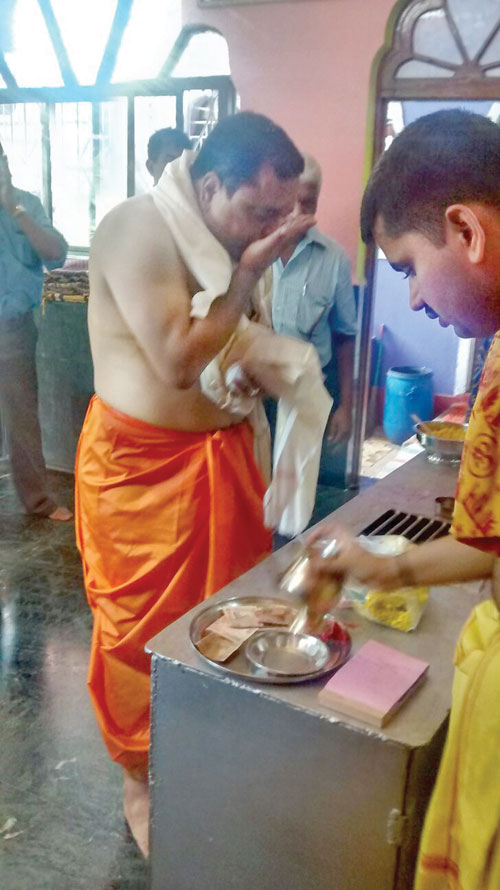Goa is abuzz with excitement as vintage bike and car owners, users, collectors and fans are decking […]

CATHOLICS ARE NOT HINDUS
Dec 24 - Dec 30 2016, Opinion December 24, 2016TURNED COLOURS: Mauvin Godinho, the Babush Monserrate of Vasco has literally adopted Hindu Saraswat clothes to prove his loyalty to Sangh Parivar which he joined recently
Contrary Manohar Parrikar’s claim, Goan Catholics have their own individual identity. It is unfortunate that they are being marginalised to the extent that not enough cash has been made available even for shopping for Christmas. Instead, the Finance ministry and the Reserve Bank of India have abruptly stopped permission to deposit hard earned cash in banks granted up to December 30
By Albertina Almeida, Amita Kanekar, Dale Luis Menezes, Jason Keith Fernandes & R Benedito Ferrao
CAN a Goan Catholic be Hindu? Can Catholics professing a tradition of Catholicism that is over five centuries old be considered Hindu in culture? This is what former Goa chief minister Manohar Parrikar sought to suggest in an interview with Sambuddha Mitra Mustafi of the New York Times India blog India Ink, where he said: “India is a Hindu nation in the cultural sense. A Catholic in Goa is also Hindu culturally, because his practices don’t match with Catholics in Brazil [a former Portuguese outpost like Goa]; except in the religious aspect, a Goan Catholic’s way of thinking and practice matches a Hindu’s.”
Parrikar’s bizarre statement was in response to the question of whether he saw himself as a Hindu nationalist. A quick and easy response to his statement would be to summarily dismiss it as expected rhetoric flowing from his saffron affiliations; yet, questions persist, not least because of the peculiar and oft-misrepresented Goan scenario.
GOAN CATHOLICS
GOAN Catholics today find themselves in a strange situation. On the one hand they are summoned to maintain a distinct Goan identity which rests in large part on the Portuguese past of the territory. This distinct identity is called upon not merely by an officially approved tourism policy and practice, but also by local elites who use the claim of a distinct identity to cyclically generate local mass movements that help them maintain their dominance. On the other hand, as Victor Ferrão argues in his book Being a Goan Christian: The Politics of Identity, Rift and Synthesis (2011), there is a simultaneous suggestion that this Catholic ‘cultural’ element is not compatible with a Goan and Indian identity; this is precisely what Parrikar is proposing here. What he further does is to paint the community as a monolithic entity, despite a situation where large segments of the Catholics are being delegitimised by dominant-caste members of their own faith who participate in a Hindu nationalist reading of Goan history. Parrikar’s statement also distorts history through a saffron lens, contributing to the further marginalisation of not only Goan Catholics, but also Goan Muslims, Dalits, and Adivasis.
CASTE BELIEFS
FINALLY, when Parrikar says that his Hindu faith has nothing to do with governance, he is cleverly skirting the intimate connection that religion and caste ideologies, including the right-wing one he professes, have with state apparatuses in post-1947 India. In the political mobilizations of the dominant as well as the subaltern sections in India, religion has emerged as a potent and important factor. Our contention, not necessarily a new one, is this: that religion in post-1947 India is not a personal affair; it is deeply public and profoundly political, and has now become even more overtly so with the rise of the Bharatiya Janata Party (BJP).
Goa’s encounter with Christianity
This background of political machinations and mobilisations makes it even more necessary to unpack Parrikar’s statement against the actual historical context in which Goa and Goans encountered Christianity. As has been pointed out by the historian R E Frykenberg in his book Christianity in India: From the Beginning to the Present (2008), despite appearances to the contrary, the transmission of Christianity from the proselytiser to the converted always involved shifts in practice. These shifts resulted in new and unique forms of Catholicism or Christianity as the converted took in the message of the faith and made it their own. Thus, when Parrikar views a Goan Catholic as different from “Catholics in Brazil”, he is right only to the extent that there would be some ethno-local differences, because the local culture of Goan Catholics is Goan culture in its multiple variations, including, but not limited to, Hindu culture. Further, just as there are many shades in Goan identity, as also with the universality of Catholicism, there are many identities of the Brazilian Catholic. So which Brazilian Catholic is Parrikar referring to? Or is this also part of the fascist project – to understand every community or region everywhere in terms of its majority or dominant group?
Not a Hindu space
WHEN Parrikar suggests that the Catholic in Goa is culturally a Hindu, and that Hindus and Catholics in Goa match in their practices and ways of thinking, he lends weight to a particular assumption about pre-Portuguese Goa: that it was a Hindu space. The truth, however, is that the territories that became Goa following Portuguese conquest in 1510 were, if anything, Islamicate spaces. This means that, although the majority of the people were not Muslim, they were culturally influenced by the Persian, Arabic, and Turkic traditions of dominant Muslim groups. As Phillip Wagoner and other scholars of the Deccan have pointed out, the notion of kingship in the early modern Deccan was firmly fixed within Perso-Arabic, and Turko-Afghan traditions that had taken root among the elites of the peninsula. Even the ostensibly Hindu kings of Vijayanagara adopted a vast variety of Islamicate traditions, in addition to styling themselves as “Sultans among Hindu kings”. The control of pre-Portuguese Goa shuffled between the Delhi Sultanate, the Deccan Sultanates, and the Vijayanagar kingdom for close to two centuries before the arrival of the Portuguese. In turn, this laid the ground for an Islamicate culture in the territories. So, when Parrikar proposes that Goan Catholics are culturally Hindu, he effectively obliterates the vibrant erstwhile and contemporary manifestations of the Islamicate in Goa by suggesting that the state’s society is one of Hindus and Catholics (with putative Hindu pasts) alone.
Goa’s pre-Portuguese history prior to the Islamicate period similarly reflects a complex diversity. There were communitieswho followed indigenous belief systems which cannot be considered Hindu, and ruling classes that were only recently Hindu. There is strong evidence of Jain and Buddhist communities in the Goan region in the first millennium of the Common Era, communities who were wealthy enough and politically dominant enough to leave behind fairly substantial architectural remains. While there are those who would lump both Buddhist and Jain ideas into Hinduism today, the fact is that these faiths arose and developed in opposition to brahmanical ideas. Parrikar’s statement thus erases the complex cultural life of pre-Portuguese Goa, collapsing it all into ‘Hindu Culture’ even as Hindu “practices” become the benchmark of evaluating the Goanness and Indianness of a Goan Catholic.
lesser citizens
PARRIKAR’S assertion that Catholics are culturally Hindus has another insidious side to it, for it draws from the old accusation of Hindu nationalist historians that Christianity and Islam are foreign to India. While Parrikar may not have actually said that Christianity is foreign, his statement makes it foreign. The truth though is that just as the Christians of the subcontinent are not foreign, their practices embody the culture of the land too. To label such culture as Hindu is not just erroneous, but also pernicious. As a corollary question to Parrikar’s logic, are Hindus living in Christian-dominated countries ‘culturally Christians’?
As Victor Ferrão demonstrates in his book, assuming and asserting a Hindu or brahmanical character to pre-colonial Goa has another ramification. It brings into play the purity and pollution principle that structures caste life within the political realm. The colonial period, and the colonial introduction of Christianity, is seen as polluting the former purity of the Hindu body politic. Consequently, Catholics are placed outside the purview of legitimate citizenship in Goa and India, because the nation’s purity is predicated upon assumptions of its essential brahmanical Hinduness. In Ferrão’s words: “Being polluted by the colonial era, [the Catholics] are thought to have lost their ability to take Goa to the path of authentic progress”. The Catholics may remain in Goa, but every time they make a demand that challenges the assumptions of Hindu nationalism, they are charged as being anti-nationals. This can be seen in the response to the demands for the recognition of the Konkani language in the Roman script, as also the demand for state grants for primary education in English. Thus, even though Parrikar’s statement on the cultural essence of Goan Catholics may seem to embrace, it is in fact a reminder of the second class location of that community within the Goan polity.
SECOND CLASS
REINFORCING clichés of the nationalist historiography of India
The assertion that the term ‘Hindu’ “is cultural” rather than “religious” privileges only a certain rigid notion of Hindu culture and way of life, while relegating anything that is not Hindu to a second class status; this of course also begs the questions as to which religion is not a prescription for a way of life? It also relegates everybody in India who is not of the ‘Semitic’ faiths into the category of ‘Hindu’ by default. Such co-option has been challenged in Jharkhand where a struggle is on to give official status to the local Sarna religion. Dr. Ram Dayal Munda, the former vice chancellor of Ranchi University, has written in detail about how the Sarna faith differs in cosmology, myths, deities, rituals, priesthood, and other details, from Hinduism. Yet for many like Parrikar, non-Christian and non-Muslim Adivasis are ‘automatically’ Hindu. Kancha Ilaiah also discusses similar processes in his path-breaking book Why I am not a Hindu (1996). Ilaiah points out that for many children of subaltern communities even in the 20th century, the introduction to Hindu deities, epics, rituals, and other traditions happened only when they joined school, and the novelty was on par with learning Christian faith traditions.
Parrikar’s assertion that Hindus do not attack except in self-defence, i.e. they are a peaceful and tolerant people, is another myth that has been successfully contested by historians as well as scholars of contemporary caste society. That the Hindu nationalists play the card of perpetual victimisation, as Parrikar does, when in reality it is the Dalits, Adivasis and many minority groups who are violently oppressed and abused by the caste nature of South Asian society, a society whose ethos, traditions and survival are now championed by Hindutva politics, is an old irony. As for peacefulness, Parrikar may never take up a sword to kill, but he is already neck-deep in a discourse that is violently casteist, racist, and – not to forget – Islamophobic. Furthermore, he does not have to personally pick up a sword because the Hindu right-wing has set up several proxy organisations that do the job, while political leaders like him either plead helplessness or remonstrate that such violence is not ‘true’ Hinduism.
UNIVERSAL CHURCH
WHAT Parrikar and others who think like him should acknowledge is that many of the converts to Christianity were from the subaltern communities. But it is also necessary to acknowledge that the Church hierarchy in Goa is not only dominated by upper-caste Catholics, but displays a tendency to discriminate against the subalterns in a manner similar to that of Hindu caste society. There are many examples of this, as when the demand for the Roman script of the Konkani language to be given official recognition in the state, which was made by subaltern-caste and -class Catholics, was opposed by the sections of the Catholic clergy. Ironically, many of those clergy members themselves use the Roman script on a daily basis. The discrimination against the subaltern Catholic groups is intensified by the tendency of the Hindu Bahujan Samaj to ally with the Hindu dominant castes. This tendency is most evident in the way the Saraswat-led Konkani language establishment allied with the Hindu Bahujan leadership to ensure that English language education at the primary school level was denied state grants; a move that the Catholic hierarchy acquiesced to. Grants were thus reserved for schools offering education in Marathi or official (Nagri) Konkani, a move which seriously hurt only poorer (and subaltern-caste) Catholic families, the wealthy being able to shift their wards to private schools where they could continue with an education in English.
Goan Catholics are not Hindu. Most never were. The reality and history of Goa militate against the simplistic concepts offered by Parrikar. His understanding of universal Hinduness deliberately excludes the minorities while at the same time strait-jacketing and leveling any differences from the point of view of the dominant sections of the majority community. Such notions may appear to unite communities but in reality foster discrimination.
Courtesy: Round Table India















